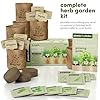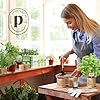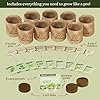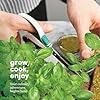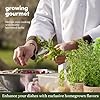1MORE Galvanized Raised Garden Bed- Planter Garden Boxes Outdoor, Raised Beds for Gardening, 4x2x1ft Metal Garden Bed Kit for Vegetables Flower, Planter Raised Beds with Tools.White-2pack
$55.99 (as of 14:06 GMT -05:00 - More infoProduct prices and availability are accurate as of the date/time indicated and are subject to change. Any price and availability information displayed on [relevant Amazon Site(s), as applicable] at the time of purchase will apply to the purchase of this product.)DIIYIV Galvanized Raised Garden Bed with Legs,2PCS 48×18×30in Elevated Planter Box for Backyard,Outdoor Garden, Patio, Balcony, 300lb Capacity,Sliver
18% OffUnderstanding Edible Landscaping
What is Edible Landscaping?
Edible landscaping is not just a trendy term; it’s a way of intertwining beauty and functionality in your garden. Instead of just planting ornamental plants, I’ve started integrating fruits, vegetables, and herbs into my landscape designs. It transforms my outdoor space into a sanctuary of color and flavor!
When I first dived into edible landscaping, I was amazed at how many edible plants are stunning. Think edible flowers, vibrant berries, and lush greens! Each plant adds a splash of color while also providing delicious homegrown food. It’s genuinely rewarding to grow in a way that pleases both the eye and the palate.
Creating an edible landscape encourages biodiversity, attracting various wildlife and pollinators, and it also minimizes waste since you can use the harvest directly from your backyard. Imagine tossing a fresh basil leaf or a handful of cherry tomatoes into your dinner—nothing beats that!
Choosing the Right Plants
Assessing Your Space
Before I started picking out plants, I took a good look at my space. It’s crucial to understand how much sun, shade, and moisture your garden gets throughout the day. Some plants thrive in full sun, while others prefer partial shade. I learned this the hard way when my poor little lettuce seedlings went limp from too much heat!
Measurements matter, too! Think about what areas you want to use and how much room each plant needs to grow. For instance, if you’re squeezing in a row of strawberry plants, don’t forget to leave space for runners and decent airflow. It gets them thriving and helps prevent any fungal issues.
Also think about your climate and soil type. What worked for me might not work for you if you live in a different zone. So, check out local gardening centers—they’re goldmines of regional gardening advice!
Designing Your Garden Layout
Creating Zones in the Garden
In my experience, setting up zones made a world of difference. I dedicated spaces for herbs, salad greens, and fruit plants. It not only organizes everything but also makes caring for them a lot simpler. I know exactly where to go when I need fresh cilantro or some juicy tomatoes!
Mixing taller plants with shorter ones maximizes space and looks good too! I have my towering sunflowers next to shorter peppers, giving the whole setup a layered effect. Plus, I’ve found that taller plants can provide shade for their smaller neighbors, protecting them from the scorching afternoon sun.
Additionally, I play with paths and borders to define sections. Whether it’s with stones, wood, or mulch, creating these boundaries makes the whole area feel like a beautiful little ecosystem where edible wonders flourish!
Maintenance and Care Tips
Watering and Fertilizing
Finding the right watering schedule was a bit of trial and error for me. It’s easy to overwater or underwater, so keeping a close eye on soil moisture levels is key. I usually check the top inch of soil; if it feels dry, it’s time to give my plants a drink! Remember, they need watering daily in the heat of summer.
Fertilizing is crucial, too. I like to use organic compost every few weeks. Not only does it enrich the soil, but it’s also more sustainable than chemical fertilizers. And hey, if I can boost my plants without harsh chemicals, that’s a win-win!
Keeping an eye out for pests has become part of my routine as well. I use a mix of companion planting and natural pest deterrents. There’s nothing like spotting ladybugs munching on aphids. Nature has its way of balancing things out if we just give it a nudge!
Harvesting and Enjoying Your Produce
The Joy of Harvesting
Harvest time is the best part! There’s simply no feeling like walking into the garden and picking fresh ingredients for dinner. I often grab some tomatoes, sprinkle in herbs, and call it a salad. Everything tastes better straight from the garden, in my humble opinion.
I’ve made it a habit to pick produce at its peak. This not only enhances flavor but also encourages the plants to produce even more. For example, if I keep harvesting my zucchinis regularly, they just keep on giving!
Finally, I love sharing my bounty with friends and family. It feels great to invite them over and serve a meal made from my garden. Plus, it inspires others to think about where their food comes from. Edible landscaping really is a way of life!
FAQ
1. What is edible landscaping?
Edible landscaping combines aesthetic gardening with food production by integrating fruits, vegetables, and herbs into the landscape. This approach beautifies your outdoor space while providing a sustainable source of fresh produce.
2. How do I choose the right plants for my garden?
Start by assessing your garden’s sunlight, shade, and moisture levels. Choose plants that fit these conditions and consider your local climate for the best results. Don’t forget to think about how much space each plant needs to grow!
3. What are some tips for designing an edible garden layout?
Creating designated zones for different types of plants helps maintain organization. Mix taller plants with shorter ones, and use pathways to define sections. This makes care easier and creates a visually appealing landscape.
4. How do I maintain and care for my edible plants?
Regular watering is key, so check soil moisture often. Use organic compost to enrich the soil, and be vigilant about identifying and addressing pests using natural solutions whenever possible.
5. What should I do when it’s time to harvest?
Enjoy harvesting at peak ripeness for the best flavor. Make it a habit to regularly pick produce, as this encourages the plants to keep growing. Share your fresh bounty with others to spread the joy of gardening!
Related Content
- Helena commission debates path forward for residential compost collection – KTVH
- Leura environmental group hosts session on composting | Blue Mountains Gazette | Katoomba, NSW
- Creative Ideas And Practical Gardening Advice
- Great Barrington: Virtual program covers fall garden chores | Community News | berkshireeagle.com
- Update On NNHS Threat | D204 Boundary Concerns | Park District Award


































